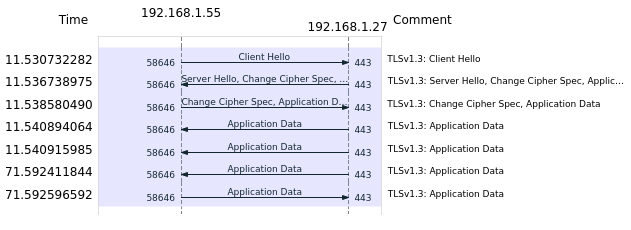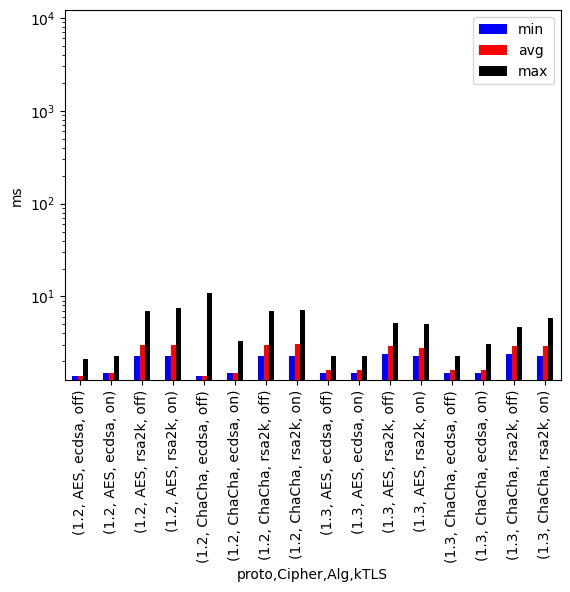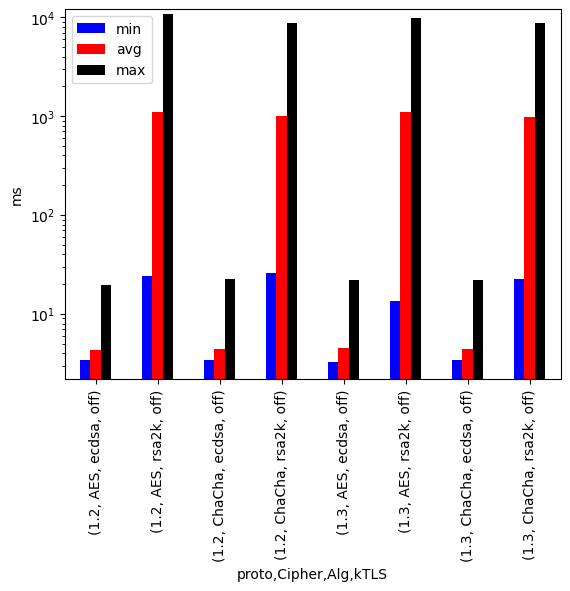Tls handshake schnell sicher
Introduction
TLS is a cryptographic protocol used to encrypt data transfer between communication partners. It is located in the application layer of the Internet Protocol Suite (IP Suite) or in the presentation layer of the OSI model. It is typically used as a wrapper for other (insecure) protocols like HTTP or SMTP. Besides encryption TLS could be used for identification purposes of both communication partners. There are several versions of TLS with versions below 1.2 being deprecated. The current versions 1.2[1] and 1.3[2] dropped support of unsecure hash functions like MD5 or SHA224. An unconfigured v1.3 connection defaults to the cipher suite AES256_GCM_SHA384.
Connection Handshake


A typical v1.2 connection without client authentication is done as follows:
- Client Hello: Client initiates connection to the Server, transmitting list of supported cipher suites, possibly indicating requiring server certificate status information (OCSP-stapling via flag status_request)
- Server Hello: Server replies chosen supported cipher suite
- Server-Certificate-Exchange: Server sends its certificate along with certificate chain (also sends valid OCSP-response if OCSP-stapling is configured)
- Client-Certificate-Exchange: Client acknowledges validity of certificate
- Session-Ticket: Client generates session ticket using on of the following methods:
- - random data created with public key of the server
- - random key via Diffie-Hellmann-Key-Exchange
In v1.3 this was revised to speed up the handshake, it now is as follows:
- Client Hello: Client initiates Connection to the Server, sends list of supported cipher suites
- Server Hello and Change Cipher Spec:
- - If Server knows and supports one of the cipher suites, Server sends its certificate, certifcate chain, possibly OCSP-response
- - Server signals started encrypted messaging
- Client Change Cipher Spec: Client responds that it also has started encrypted messaging
Unlike version 1.2 the version 1.3 does not allow renegotiation to an unsafe lower version by a request anymore, but rather refuses to complete the handshake. Therefore a connection is not established. Checking of the server or client certificate is implementation dependent, but strongly advised, as to not establish connections with a malicious actor using a compromised certificate. This not only implies building the issuer chain up to a trusted point, but also revocation checking of the certificate in question, either by OCSP[3] (Online Certificate Status Protocol), which is the preferred option, or by CRL[4] (Certificate Revocation List]. Both methods are subject to DOS-attacks, due to this for example Chromium-based web browsers do not use either of the methods when connecting to https-addresses, but rather rely on built in CA white-/blacklists.
Performance considerations
Instead of the standard AES-256-algorithm the ChaCha20-algorithm may be used. This algorithm is typically faster than a software implementation of AES-256. However current CPUs have instructions to execute AES in hardware, which can be used by tools like openssl. A comparison of a openssl-speedtest with and without usage of CPU instructions for AES as well as for ChaCha20 on a Intel Xeon Gold 6150 yields the following results, the OPENSSL_ia32cap[5] was used to disable the AES CPU-instructions for testing:
$ OPENSSL_ia32cap="~0x200000200000000" openssl speed -elapsed -aead -evp aes-256-gcm $ openssl speed -elapsed -aead -evp aes-256-gcm $ openssl speed -elapsed -aead -evp chacha20-poly1305 type 2 bytes 31 bytes 136 bytes 1024 bytes 8192 bytes 16384 bytes AES-256-GCM 3912.58k 43681.83k 119433.57k 220805.46k 240091.14k 241401.86k AES-256-GCM 12352.14k 156771.30k 600536.56k 2364060.33k 3829205.67k 4008596.82k ChaCha20-Poly1305 5406.06k 79034.59k 256344.41k 1439373.99k 2491817.98k 2634612.74k
Other factors that may lead to a performance gain in Unixoid operating systems is kernel TLS (kTLS)[6][7] wherein the TLS-workflow is completely offloaded from the userspace program to kernelspace functions. The kernel used has to support this, it is typically available since Linux kernel version 5.1 (AES-256-GCM) or 5.11 (CHACHA20-POLY1305) since FreeBSD 13.0[8] and can be queried via the following command
$ lsmod|grep tls tls 151552 0
Furthermore the application also must have support for kTLS, either built in or by using external libraries such as openssl. Definite usage by programms is tracked via the following counters, wherein TlsTxSw means 91967 served connections used the kTLS-function, but nothing uses it at the moment of querying.
$ cat /proc/net/tls_stat TlsCurrTxSw 0 TlsCurrRxSw 0 TlsCurrTxDevice 0 TlsCurrRxDevice 0 TlsTxSw 91967 TlsRxSw 0 TlsTxDevice 0 TlsRxDevice 0 TlsDecryptError 0 TlsRxDeviceResync 0 TlsDecryptRetry 0 TlsRxNoPadViolation 0
Since the linux kernel 4.13 it is possible to offload TLS to the kernel level (known as kTLS). This should lead to better performance because it saves context switches between the user level TLS implementation and the network stack.
We deployed kTLS on various machines, but we could not get a significant performance improvement.
Exemplary the biggest difference was produced on a VPS (1 vCore, 1GB RAM), set up with nginx and a 10MB file, having 10 parallel downloads:
| time | throughput | |
|---|---|---|
| kTLS enabled (ø) | 4.57s | 112.52 MBit/s |
| kTLS disabled (ø) | 4.73s | 108.07 MBit/s |
On this machine kTLS only improved the throughput about 3.9%, which does not seem significant to us because it was an virtualized platform.
A more realistic test was run using httperf and a real access log from a production server. The first 10000 connections of the log where queried using 500 parallel connections (i.e. clients) on an Intel Xeon Gold 6150[9] with 96 GB RAM under OpenSuSE 15.6 and on a Raspberry Pi 4[[10]] with 8 GB RAM and CentOS 9 Stream. Both systems used the nginx webserver since this was readily configurable with kTLS. The tests where performed three times and the median was chosen for the evaluation. Note that the graphs are log scaled. It is easily visible, that using ECC-key material instead of RSA-key material is way more influential performance wise than using kTLS, especially on the Rapsberry Pi 4.
-
Intel Xeon Gold 6150
-
Raspberry Pi 4
how to: fast and safe SSL handshake
- OCSP is not supported anymore by Let's Encypt due to privacy concerns and extensive resource requirements
- But Chromium derivates do not use OCSP/CRL by default, anyways
- only use TLSv1.2 and newer with recommended ciphers from the BSI [11][12]
- use elliptic curve for keys
- if possible, use SSL offloading to hardware
- kTLS doesn't seem to make a measurable improvement
for those, who are interested
Enable kTLS
- Check if kTLS is supported on your instance?
- -
$ lsmod | grep tls
- -
- Check if your web server was built with kTLS support
- - Most times, you can find it within the building parameters.
- Enable kTLS in our webserver
- - using
nginx:- - Add
ssl_conf_command Options KTLS;to the server section.
- - Add
- - Verify it by enabling debug printouts.
- - You should see lines containing
BIO_get_ktls_sendandSSL_sendfile. - - Alternatively verify by looking into
/proc/net/tls_stat. - - using
apache2:- - No kTLS implemented, possibly due to low impact, but
- - Add
EnableSendfile Onto your config. (see the doc)
- - using
lighttpd:- - Add
ssl.openssl.ssl-conf-cmd += ("Options" => "-KTLS")[13]
- - Add
- - In general, you should be able to verify the changes using a benchmarking tool like
aborhttperf. - - Check in
/proc/net/tls_statat server runtime
- - using
- Use ECC key material, e.g. using NIST-p256 curve
- Use hardware with CPU-instructions for ciphers, e.g. AESENC/AESDEC on x86-CPUs, or with bespoke crypto hardware[14].

